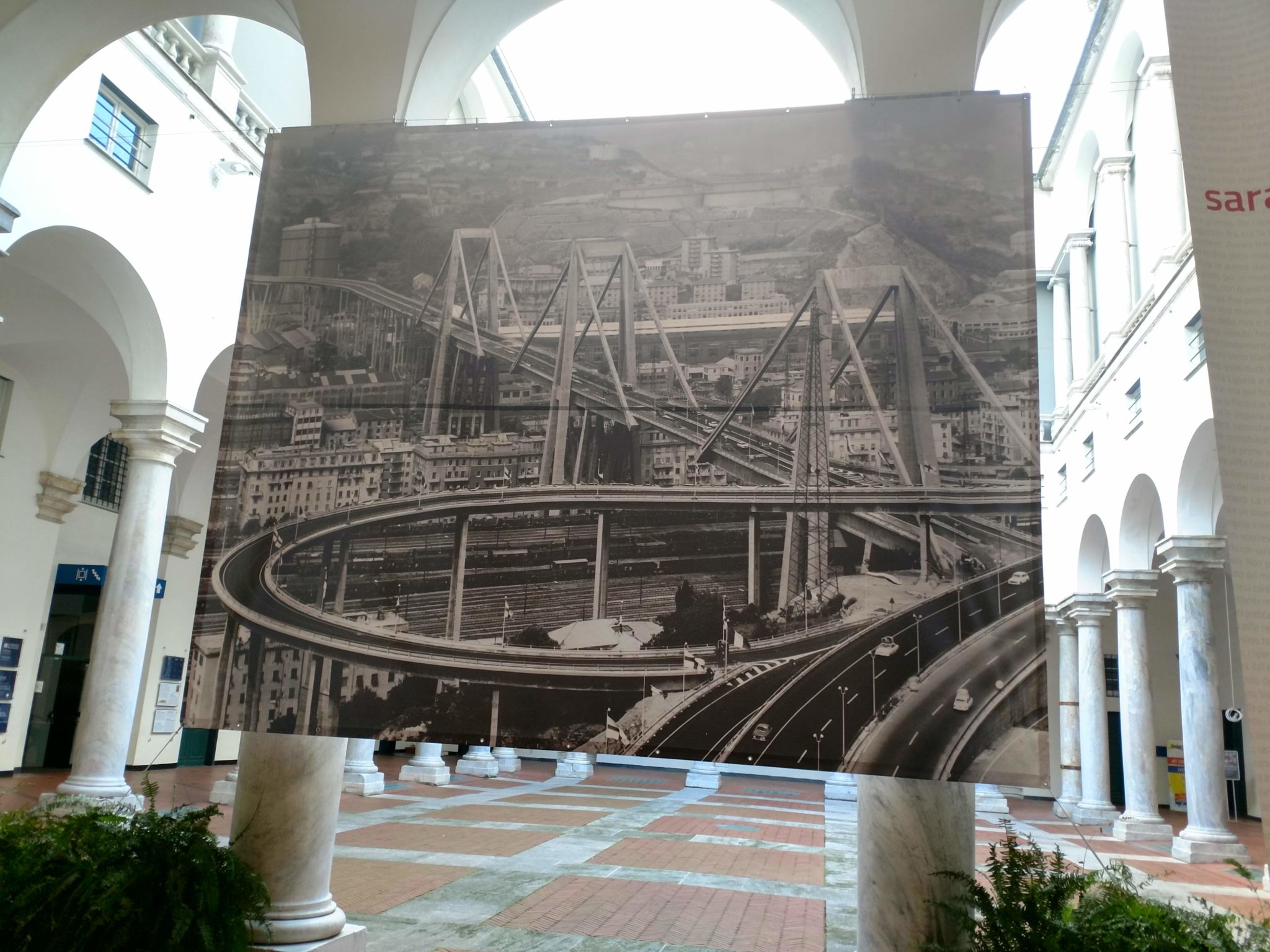Article begins
What it means to rebuild in neoliberal times.
On August 14, 2018, a large segment of the Morandi Bridge on Italy’s A20 highway connecting Genoa’s western outskirts to Milan, Turin, and France collapsed in a cloud of dust and heavy debris. Forty-three people died, many more were injured, and about 600 residents had to leave their homes. Inaugurated in 1967, the bridge had been celebrated as a solution to the heavy flow of traffic generated by Genoa’s then-thriving industrial port. Acclaimed in the national media as a monument to Italy’s modernization, the bridge hovered above several apartment complexes in Sampierdarena, one of Genoa’s working-class urban peripheries. The concerns that had been raised by residents and local Communist Party members about having a highway float right above a densely populated area had been easily brushed off by developers and administrators in the name of progress. While it made traffic to and from Genoa’s port and its factories more efficient, the bridge also became an intrusive companion: one that cast a permanent shade on the neighborhood as it kept producing smog and incessant noise. Over time, residents entered a state of resigned quiescence over the bridge’s cumbersome presence. They even gave it a nickname: “il Brooklyn,” the Brooklyn Bridge, as a somewhat alien, and yet familiar, element that provided a background to their everyday lives.
Frugality, a rugged simplicity, and a familiarity with the sea are commonly associated with Genoese-ness and have been honed over the centuries.
As disasters in neoliberal times often do, the collapse of the bridge incited resilience among the Genoese. Reaching out to fellow residents who had been rendered homeless, many Genoese opened their homes to the families whose apartments were located under the crumbling bridge. Social media platforms played a core role in the coalescing of this emotion: they allowed residents to voice their experiences, memories, and feelings even as they circulated images of, and praises for, a bereaved but also brave and beautiful city. Picking up on this collective mood in December 2018, Genoa’s administration inaugurated Quella volta sul ponte, (That Time on the Bridge), an exhibition of written texts featuring Sampierdarena residents’ memories of the Morandi Bridge. Starkly at odds with the institutional neglect that had surrounded the lives of Sampierdarena residents before the collapse, this exhibition cast a sympathetic gaze on the intimate, and often touching, ways in which people living in the apartment complexes under the bridge had incorporated the alien modernist structure of “il Brooklyn” into their everyday lives.

The Morandi Bridge Poster Displayed at Genoa’s That Time Over the Bridge Exhibition in December 2018. Emanuela Guano
Only a few weeks earlier, popular archistar (starchitect) Renzo Piano had announced he would design the new bridge. Selected by a conservative administration—the first to hold power in the city the end of Word War II—that is strategically attuned to the moods of its citizenry, the choice of Renzo Piano merged multiple threads of a complex affective and symbolic bundle: Piano is a Genoese of international renown who still maintains an office and a residence in his hometown. He is also the designer of the popular waterfront that has greatly contributed to Genoa’s transformation into a tourist destination. Just as importantly, Piano is adept at speaking a language that resonates with local publics and their ways of imagining the city. In Piano’s own words, this bridge will be “simple and frugal, a truly Genoese bridge.” He also envisioned “a steel bridge—one that is as shiny and limpid as a boat, and endowed with a clear soul that will support the city in mourning this terrible loss.” Frugality, a rugged simplicity, and a familiarity with the sea are commonly associated with Genoese-ness and have been honed over the centuries. They are also the resilient qualities that have harnessed much praise in the face of Genoa’s recurring twenty-first-century disasters—floods, rough seas, and the violence during the 2001 Group of Eight Summit in the city. In his speech, however, Piano also acknowledged the collective trauma: the loss of lives; the disorientation of the evicted, and the sudden demise of a landmark that had represented Genoa’s long-lost industrial prosperity.
Indeed, Genoa’s ailing economy needs a new bridge. Yet, the poetics of infrastructures often unfolds independently of the latter’s material purposes and technical functions. Piano’s plans for rebuilding the bridge, I suggest, partake of a kind of neoliberal urbanism that promotes consent by harnessing affect—in this case an appeal to an identity that encourages both resilience and hope for a better future. With a bow to the current post-political attention to collectively voiced emotions, Piano’s plans for the new bridge purport to soothe the grief of the Genoese even as they resonate with a local imaginary infused with emotions. Just as importantly, archistar Piano pledges to accomplish this feat in style, by contributing his international reputation and visibility to the branding of Genoa for the global tourist scene.
Emanuela Guano is professor of anthropology at Georgia State University. She has conducted ethnographic research on urban space, gender, and class identities in Argentina and Italy, and most recently is the author of Creative Urbanity: An Italian Middle Class in the Shade of Revitalization. Guano’s current research interests include urban aesthetics and the resistance to redevelopment in Italy’s postindustrial urban peripheries.
Interested in submitting news, announcements, contributions, and comments? Please contact SUNTA contributing editor Faedah M. Totah ([email protected]).
Cite as: Guano, Emanuela. 2019. “Emotions, Archistars, and Genoa’s New Bridge.” Anthropology News website, February 18, 2019. DOI: 10.1111/AN.1094

